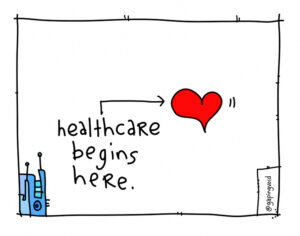The Digital Evolution of Primary Care: An Analysis and a Path Forward

Last month I was honoured to be part of a panel on the state of Digital Health in Primary Care, at the Rotman School of Business, University of Toronto. The panel discussion with three other esteemed colleagues (Sonya Lockyer – Lifemark; Dov Klein – Ontario Health; Zayna Kayat – Deloitte/Teledoc) centred around digital health processes and tools. We discussed the current state of primary care technology and its use. I opened with a clinical perspective. The landscape is evolving, but there are challenges to be addressed. Here are my main points.
The Current State: Digital Records & Data Silos

As of now, a staggering 90% of physicians and community doctors utilize an electronic medical record (EMR). Yet, most of these remain isolated in basements and tucked-away closets. Data sharing is virtually nonexistent. While a third of these records reside in the cloud, these cloud instances still don’t communicate with one another. While strides have been made in getting doctors access to larger patient information sets via Ontario Health repositories such as OLIS, DHDR, DHIR, Connecting Ontario, and Clinical Connect, there’s still information that slips through the cracks. Additionally, the effort required to log into these systems deters many from using them. We seem to have moved very little in the past five years on data following the patient for best continuity of care.
The Virtual Care Conundrum
The pandemic saw a swift adoption of virtual care. However, as government funding decreased post-Covid, the momentum has begun to wane. A significant reason is the disconnect between virtual care clinics and organized primary care networks and teams. Often, virtual care emphasizes high volume and low complexity, while the real demand lies in the opposite spectrum: low volume but high complexity care. And the companies compete with primary care clinics, not cooperate with them. This presents a problem in continuity and is loathed by both medical associations and governments who both support decreasing funding to stand-alone virtual providers. This has forced many to go directly to the patient for pay. There is no incentive to integrate into the larger system.
More Than Just Virtual: The Digital Health Spectrum
Digital health extends beyond mere virtual consultations. Yet, clinicians often shoulder the burden of costs and risks with digital health tools, from acquisition to integration. There’s no centralized system for product vetting, leaving many without guidance. Beyond initial EMR grants, now mostly gone, governments and often even private payors do not want to invest in practices improving their technology. Doctors are out of pocket and there is no way to recoup the costs. New technology is not yet seen as a valid overhead expense increase in our negotiated pay agreements. Adoption stagnates. Technology advances popular in other professions and in business then pass us by.

Primary Care’s Transitioning Landscape
Primary care is in flux. While governments advocate for pathways of care and managed care, real-life scenarios are more intricate. Patients don’t fit into the neat categories these pathways outline. Thus, they are underused. Networks of primary care physicians, like Ontario Health Teams, are emerging, though their momentum was diminished by Covid. It will take a lot to bring that back. We are, simply, tired.
Patient expectations are evolving. They rightfully expect faster service, more control over their health and data, and enhanced knowledge. We’re also witnessing a shift from traditional family doctor setups to alternative primary care environments, like nursing clinics and pharmacies. There’s a strong call for comprehensive care teams, but these remain scattered and in Ontario for instance, available to only about 25 % of the population. When teams exist they are often understaffed and so wait lists to see allied health providers remain long. And it is hard to get them to accept complex or complicated patients.
Furthermore, educational trajectories are shifting. More students opt for specialty practices instead of family medicine for various reasons, such as the demanding administrative load on comprehensive family doctors, more control over their time, and differential pay scales. Family Medicine certification in Canada will likely be moving to three years of training rather than two, with many doctors adding a fourth subspecialty year onto that. There is a distinct lack of focus on comprehensive longitudinal care. As well, younger doctors are working fewer hours, wanting to stave off the potential for burnout from an unbalanced lifestyle, which their older peers have experienced.

A Bright Future Ahead
Despite these challenges, the potential for transformative change is vast. With advancements in AI and office automation, we can lighten the workload of practitioners. Digital tools can help us extract more insights from scattered data. By democratizing knowledge, patients can turn to doctors for wisdom rather than just facts and tests.
For this vision to be realized, investment in digital tools is crucial. Whether funded by governments or doctors themselves, we can’t keep stalling partnerships between private and public sectors. We must build trust and stop thinking that industry is inherently bad because they seek profit, or government is inherently bad because they move slowly and have little appetite for risk. We must meet in the middle. For developers and innovators, aligning with primary care providers to understand their real-time needs will ensure more successful, trusted products. Policy must get out of the way of innovation.
While the journey towards a fully digital primary care landscape has its obstacles, the future is bright. With collaboration, investment, and trust, we can revolutionize healthcare for all. Really, we have no choice.


4 Replies to “The Digital Evolution of Primary Care: An Analysis and a Path Forward”
Nice article. If you could make one policy change to convince new Med grads to choose family medicine, what would it be?
So much more than one.
In the world of policy, make attention to primary care the starting point not the end point. In every table discussion impact of funding, technology, new laws, privacy, work flows or anything have the first question be “what will the impact on our base for primary care be?”. If the question cannot be answered, do not move forward. If the answer is negative, do not move forward. If the answer is obvious, move forward but monitor closely in case the answer is wrong.
How about you? What would you do??
Also, as a society, we must come back to rewarding generalism. And caring. And comprehensiveness. A much harder task.
Bang on Darren. To your point, AB spent $4B on ConnectCare from Epic. The portal to connect to primary care was an afterthought patch, as opposed to baked in connectivity. Since the rollout in my area, it takes me twice as long to get through my inbox of lab and result data because I have to categorize it manually, or it is slightly altered in format and does not trend in a database properly, or the formatting makes it difficult to skim and extract the information, etc. etc.
Imagine if the mandate from the outset was to design an institutional EMR that was an efficient hub to primary care as well? To answer Charles above, that would be part of my second policy initiative: Data flows to the right provider at the right place at the right time. (The first policy change would enable competitive compensation for FP’s providing accountable team based care – I work at a 40+% discount in my clinic versus in our local hospital. That basic economic has to be fixed. But I digress…)
Adam, your digressions are pure gold. You have explicitly called out the disconnect between how things usually happen in these projects, and how we all know that they SHOULD happen with appropriate attention being paid to the ripple effects of change. Primary care, as the base of the system, is usually an afterthought. This is the opposite of how it should be. But as we are the cheapest and quietest part of the system, and the one that adapts, flexes and bends the most easily, we are often overlooked.
Thank you. Keep the thoughts coming.